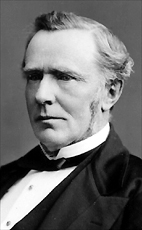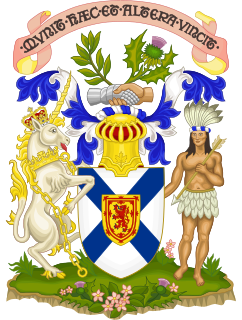Related Research Articles
The Canadian order of precedence is a nominal and symbolic hierarchy of important positions within the governing institutions of Canada. It has no legal standing but is used to dictate ceremonial protocol.

Joseph Howe, was a Nova Scotian journalist, politician, public servant, and poet. Howe is often ranked as one of Nova Scotia's most admired politicians and his considerable skills as a journalist and writer have made him a provincial legend.

The premier of Nova Scotia is the first minister to the lieutenant governor of the Canadian province of Nova Scotia and presides over the Executive Council of Nova Scotia. Following the Westminster system, the premier is normally the leader of the political party which has the most seats in the Nova Scotia House of Assembly who is called upon by the lieutenant governor to form a government. As the province's head of government, the premier exercises considerable power.

The Nova Scotia House of Assembly, or Legislative Assembly, is the deliberative assembly of the General Assembly of Nova Scotia of the province of Nova Scotia, Canada. The assembly is the oldest in Canada, having first sat in 1758, and in 1848 was the site of the first responsible government in the British Empire. Bills passed by the House of Assembly are given royal assent by the Lieutenant Governor of Nova Scotia in the name of the Queen.
The Executive Council of Nova Scotia is the cabinet of the Canadian province of Nova Scotia.

Each General Assembly of the legislature of the province of Nova Scotia, Canada, consists of one or more sessions and comes to an end upon dissolution and an ensuing general election. Today, the unicameral legislature is made up of two elements: the Lieutenant Governor and a legislative assembly called the House of Assembly. The legislature was first established in 1758.

Province House in Halifax is where the Nova Scotia legislative assembly, known officially as the Nova Scotia House of Assembly, has met every year since 1819, making it the longest serving legislative building in Canada. The building is Canada's oldest house of government. Standing three storeys tall, the structure is considered one of the finest examples of Palladian architecture in North America.

Archibald Woodbury McLelan, was a Canadian shipbuilder and politician, the sixth Lieutenant Governor of Nova Scotia.

James Drummond McGregor was a Canadian businessman, politician, and the tenth Lieutenant Governor of Nova Scotia.
The 1999 Nova Scotia general election was held on July 27, 1999, to elect members of the 58th House of Assembly of the Province of Nova Scotia, Canada. The government was defeated on a money bill on June 18, and the Nova Scotia House of Assembly was dissolved by Lieutenant Governor James Kinley. It was won by the Progressive Conservative party, led by Dr. John Hamm. They received a majority of 30 seats compared to 11 seats by the NDP and 11 by the Liberals.
Nova Scotia is a parliamentary democracy. Its legislature consists of the Lieutenant Governor of Nova Scotia and fifty-five members representing their electoral districts in the Nova Scotia House of Assembly. As Canada's head of state, Queen Elizabeth II is the head of Nova Scotia's chief executive government. Her duties in Nova Scotia are carried out by the Lieutenant-Governor, Arthur LeBlanc. The government is headed by the Premier, Tim Houston, who took office August 31, 2021. Halifax is home to the House of Assembly and Lieutenant-Governor. The House of Assembly has met in Halifax at Province House since 1819.

The Government of Nova Scotia refers to the provincial government of the Canadian province of Nova Scotia. Nova Scotia is one of Canada's four Atlantic Provinces, and the second-smallest province by area. The capital of the province, Halifax, is Nova Scotia's largest city and its political capital. Halifax is where the Province House, Canada's oldest legislative building, is located.
The 23rd General Assembly of Nova Scotia represented Nova Scotia between 1864 and 1867.

William Fraser McCurdy was a merchant and political figure in Nova Scotia, Canada. He represented Victoria County in the Nova Scotia House of Assembly from 1878 to 1886 as a Liberal member.
Michael Edwin Keefe was a building contractor and political figure in Nova Scotia, Canada. He represented Halifax County in the Nova Scotia House of Assembly from 1900 to 1906.
Frank Stanfield was an entrepreneur in Nova Scotia, Canada, who was the 15th Lieutenant Governor of Nova Scotia (1930–31) and represented Colchester County in the Nova Scotia House of Assembly. He was the father of the politicians Robert Lorne Stanfield and Frank Thomas Stanfield.
Moses Hardy Nickerson was a journalist, poet and political figure in Nova Scotia, Canada. He represented Shelburne County in the Nova Scotia House of Assembly from 1902 to 1911 as a Liberal member.

The Legislative Council of Nova Scotia was the upper house of the legislature of the Canadian province of Nova Scotia. It existed from 1838 to May 31, 1928. From the establishment of responsible government in 1848, members were appointed by the Lieutenant Governor of Nova Scotia on the advice of the Premier.
Cornelius Forman Hatfield was a merchant, shipbuilder, ship owner and political figure in Nova Scotia, Canada. He represented Yarmouth County in the Nova Scotia House of Assembly from 1890 to 1894 as a Liberal member.